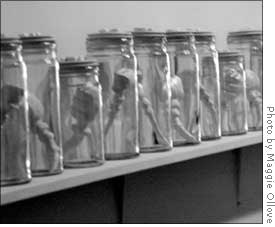
| << Front page | Arts | March 9, 2007 |
Birkhahn's Senior Art Show Is All Bottled Up
 |
||
| What’s in the Jar?: Bryn Birkhahn’s senior art show in Fisher Gallery “pro-creates” unrecognizable figures in glass vessels. | ||
Fisher Gallery underwent a startling transformation last week for Pro-creation, senior Bryn Birkhahn’s art show. The blank canvas of an empty art space became an immaculate laboratory for a crazed scientist and a fantastic model for creation, or whatever else the severe lighting, sterile jars, fetus-esque forms and stark black pedestals may have conjured up for the imaginative mind.
A sizeable crowd of students — faces obscured by shadow, hands firmly gripping PBR cans — milled around, searching for ways to approach “Trials of Life,” the main piece. They hugged the walls and talked softly in crowds of five or six. They ventured up to the edges of the light, perhaps too intimidated to go any further, and circled the four black pedestals in observation. Or they had the guts to engage more fully with the art, carefully studying the artist’s statement before peering intently at the jars holding the “embryotic/spermal creatures,” or in some cases, reaching out to glide their fingers over the plaster numbers embossed on the lids.
“Valium,” Birkhahn’s other piece, was assembled in the back room: eight blocks seemingly arranged according to color from white to tan to peach to khaki to brown — the same brown as the floors and walls. On these blocks were shallow, sectioned containers reminiscent of rectangular Petri dishes or microwaveable TV dinner trays.
Music, controlled by two sound technicians, was played throughout the exhibition. Largely beat-based, it factored prominently into the general mood of the show. Quickening like frantic heartbeats only to slow again, the music kept viewers on edge, always slightly uncomfortable.
Senior Alex Arnold noticed these meticulous, careful efforts to create a specific atmosphere that augmented the work.
“I was impressed that [Birkhahn] took the initiative to make the space work for her…she has done a lot to increase the presentation of her work,” observed Arnold. “It is both functional and aesthetically pleasing.”
Despite the excellently engineered mood of the room, the two pieces felt cold, emotionless, like the turned-out products of assembly line work. “Valium,” a prescription drug which eases tension and anxiety, the title, suggests that perhaps our over-industrialized and streamlined society, with its emphasis on consumption and materialism, fuels a desperate need for routine and artificiality. The repetition of trays was a two-dimensional approach to this idea, both aesthetically and conceptually, but was not compelling enough to produce a lasting response.
In “Trials of Life,” the search for humanity or soul inevitably brought the viewer’s gaze to the strange skeletal forms within the jars. The lingering hope that there might be one creature that was noticeably different or one element was amiss in the sea of jars never came to fruition, frustrating those who carefully examined the piece. It seemed impossible to move beyond the superficial level.
Perhaps this was the point and the message was intended to be about the sameness and monotony of creation and life. This message, while compelling, is derivative and can be found in many incarnations in art, film and literature.
The explanation provided by the artist detailed her quest for an understanding of “the elusive function of ‘art’ objects.” She also wrote that she is “pro-creation,” as in she is an artist of craft and skill. This did come through in that it was clear that all of these forms had to be individually manufactured. The two works deserve applause for their technical skill.
While the themes of sexual and technical reproduction which Birkhahn was working with were certainly apparent, her measured efforts may have obscured whatever deeper meaning could have been borne through more intense analysis of what the theme meant to the artist and should mean to the viewers.
Though it had great potential, in the end, the artwork was only aesthetically interesting and artistically engaging on one level; the setup and forms were memorable, but not in any significant way that caused further questioning or encouraged thought about the issues presented.
About us
Subscriptions
Advertising